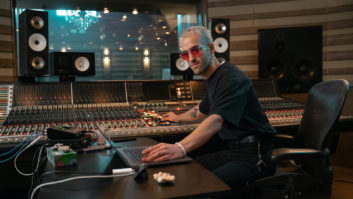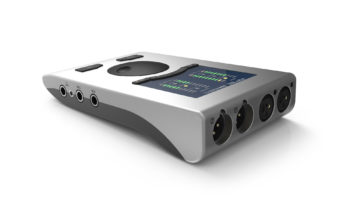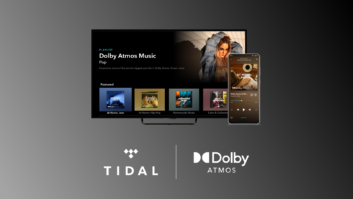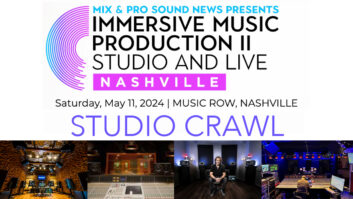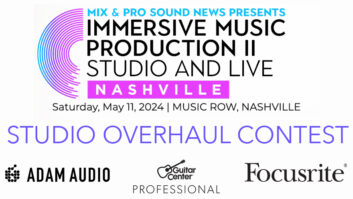
In 2019, UMG released The Beatles’ Abbey Road and Sgt Pepper’s Lonely Hearts Club Band, two of the most popular albums from one of the most popular bands, mixed in Dolby Atmos by Giles Martin. The labels have also released Atmos versions of back-catalog albums by Kraftwerk, INXS and REM. But for Dolby Atmos Music to hit critical mass, it’s surely going to require contemporary, chart-topping artists to release current albums in the immersive format.
That’s beginning to happen. Late last year, Alicia Keys previewed “Show Me Love,” the first single from her upcoming album, Alicia, mixed by George Massenburg in Atmos (Manny Marroquin mixed the original stereo version). Now comes the news that After Hours, the new album by The Weeknd, is being released in a Dolby Atmos version.
The stereo version of After Hours, released March 20, 2020, went straight to Number 1 on the Billboard 200. It’s the fourth album from The Weeknd, the professional name of Canadian artist Abel Tesfaye, and the fourth to reach Number 1. The day before release, a record number of subscribers—1.02 million—pre-added After Hours to their Apple Music libraries. All 14 tracks on the album have since charted on the Billboard Hot 100, 10 in the top 40, with one, “Blinding Lights,” reaching the top slot.
Thirteen-time Grammy-winning engineer John Hanes mixed the Dolby Atmos version of After Hours at MixStar Studios in Virginia Beach, Va. Hanes co-owns the private studio with Serban Ghenea, a 17-time Grammy-winner himself, who mixed five of the stereo album’s songs at MixStar. The pair first met while working for Teddy Riley at the artist and producer’s Future Records facility in Virginia Beach in the early 1990s. “We partnered up again in 2001 and set up our own studio,” says Hanes, a 30-year veteran of the business.
Ghenea and Hanes have an enviable discography. Think of a record from the Hot 100 over the past 20 years and they likely had a hand in its success. Highlights just from recent years include releases by Bruno Mars and Mark Ronson, Maroon 5, Halsey, Taylor Swift, Benny Blanco, Katy Perry, Kelly Clarkson, Ariana Grande, Jonas Brothers, The Weeknd and, well, you get the picture.
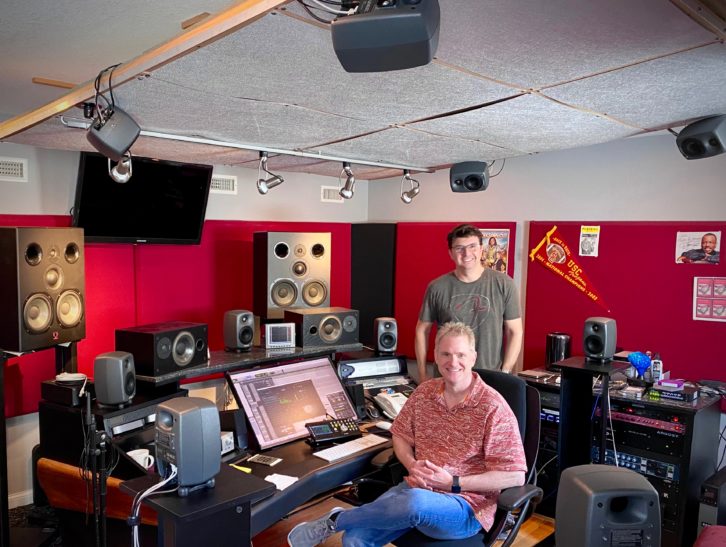
Setting Up the Studio
Hanes reports that he and Ghenea first experienced Dolby Atmos Music when a team from Amazon visited MixStar to demonstrate an early version of the company’s Echo Studio smart speaker. Recognizing the immersive format’s potential, the pair decided to start playing with the technology, adding Genelec 8320 speakers to the existing monitor setup in Hanes’ room to ultimately create a 7.1.4 setup.
“We didn’t need full-size monitors all the way around, we just needed something of an appropriate size to give us that surround,” says Hanes. “Because we’ve done the mix already, we know the EQ and everything else is already there on the speakers that we’re used to.” Plus, he says, the compact Genelecs didn’t require extra bracing in the walls or ceiling. “I started with a 5.1.2 system. I put up Ariana Grande’s ‘7 Rings.’ It’s a nice, sparse song with elements you can really move and place. That was my first experiment.”
As momentum builds behind Dolby Atmos, Hanes believes that the technology will proliferate beyond the current handful of professional music studios equipped for the immersive format. “We’re on the edge of this becoming just like the home recording boom,” he says. “[But] there’s new technology you’re going to have to learn. It’s fairly complicated.”
To begin with, because the Dolby Atmos Renderer accepts up to 128 inputs—10 for beds and 118 for objects—the system relies on a Dante transport. “You’re going to have to learn to set up a Dante system,” Hanes explains. “I’m using a Focusrite RedNet I/O box, and there’s the Dante Controller program on the computer. You have to set up the routing from box to box in the computer. I have the Grace m908 monitor controller. It’s super-flexible, but there’s a lot of programming that goes into setting it up, assigning channels to speakers, and to monitor setups. It’s maddening when you’re sending something to one speaker and it’s coming out another, and you don’t know where in the chain you’ve gone wrong.”
Stereo Mix, Atmos Mix
After Hours was something of a baptism by fire for Hanes, who was given relatively little time to create the Atmos mixes. “We were pretty under the gun. They had their tie-in release date with Amazon, so I had 10 days to mix 14 songs. The record label people said, ‘We trust you, just get it done.’”
The goal of any Atmos mix is to re-create the sound of the stereo mixes, Hanes stresses. “I know that the mixers worked so hard on creating exactly the sounds that they wanted with the artist and the producers. I had the stereo masters, so I could make it as close as I could, then start experimenting with moving things around.”
A typical stereo mix at MixStar might take a day to a day and a half in total, including review by the client. But an Atmos mix doesn’t necessarily need that much time, says Hanes. “It’s faster than a stereo mix because a lot of the decisions—volumes, edits—have been made. I’m trying to maintain all of that. I’m respecting every decision they’ve already made and trying to just not fuck it up.”
“We did some of the production two or three times on some of these songs,” says engineer Ghenea of the stereo mixes. “I’ll tweak things until the cows come home, but as soon as it starts going backwards, I’ll throw my hands up and say, ‘We had it a few versions ago.’ Except in this case it got better every time.”
Tesfaye is very specific about what he wants, Ghenea. adds “He hears the thing in his head, and he wants to get whatever it is out. Sometimes it takes a few tries; there’s a lot of trial and error. You end up with a lot of parts. Being ‘80s-inspired, there are a lot of synths and textures; there’s a lot of stuff going on.”
Mixing anything in stereo is rewarding, says Ghenea, as that’s the version the majority of listeners will hear. And it’s possible to create a three-dimensional soundstage in stereo, of course. “You’re dealing with two speakers, but you try to get the feel of an immersive experience as much as possible. My biggest concern is that you end up losing the glue, the cohesiveness [when you then mix for Atmos].”
The album’s various other producers and mixers delivered their songs as a collection of stereo stems, some of which needed work to match the masters before Hanes could start the Atmos mix.
“With Serban’s sessions, the lack of mastering doesn’t change the overall sound of the mix for Atmos,” Hanes says. “But there were some mixes where the stems didn’t fully re-create the sound of the mastered stereo mix. That’s probably due to a combination of the stereo mix master bus hitting differently with less tracks feeding it, as well as choices done in mastering the tracks.”
Establishing Beds and Objects
Working from dense digital sessions is not like remixing from a 24- or 32-track tape. “This modern music, a sort of wall of sound, sometimes doesn’t translate as well when you pick it apart and move things,” Hanes says. “Are you collapsing the imaging, are you collapsing the vibe of the song? I’m A/B’ing back and forth between the stereo mix and my Atmos mix constantly to make sure I’m in that same vein that they worked so hard to get to.”
Hanes says his overall approach was to place about half the elements of a given song into the Atmos bed, sending the remaining elements as objects around the room. “When you’re doing a stereo mix, it’s basically a two-channel bed. I’m just expanding on that.”
He’s mindful that the approach may affect translation elsewhere. “If I put this sound in a bed, it’s going to come out in some rooms along the full left or right side of the wall. I know that when I’m placing sounds, so I’m thinking of how it might translate,” he says.
The number of stems per song varied. “Until I Bleed Out,” for instance, was delivered as 25 stereo stems, the fewest of any song. “Fewer than that for a song with so much happening in it, it makes you get more creative,” says Hanes. “The music is so complicated on some of these songs. You have so much information there. It’s good to have extensive stems and everything broken out separately.”
Where there were multiple elements in a single stereo stem that he wanted to separate, Hanes had to find a technical workaround. On some stems, he says, “You end up either breaking it up and sending different things different ways or using a send to throw something to the back while the regular track is going to wherever it’s going. You drop it out of the main audio and send it to an object and automate it.”
There are still relatively few plug-ins specific to Atmos mixing. “I used all the same stuff we’ve been using for stereo,” says Hanes. But Gaffel, from Swedish developer Klevgränd Produktion, was one problem-solver for manipulating stems. “It’s a band-splitting plug-in that you can put on multiple copies of one track. Each track then has part of the band, and they’re all synchronized. I use that to split stuff up and move the highs to one place, the lows to another. You can take a stereo pad and spread it a bit from front to back.”
Since he came up in the world of mixing consoles and tape machines, he says, “My philosophy is still based on that. If I need to duplicate a track, change the EQ and use those parts to move it around, I still do some of that.”
As for reverbs, even the dedicated surround plug-ins aren’t especially useful, he says. “The Waves surround suite is 5.1, so you can’t stick it on a 7.1 track. You have to create your own stuff and understand what it means to spread something out and how to do it, using delays or whatever means necessary to manipulate the audio so that it doesn’t collapse back into mono or stereo. They’re standard techniques, just in a different dimension now.”
Hanes requested dry stems with the effects printed separately, but that wasn’t always possible, he says. “You have to be technically creative to solve the problems of being unable to separate a sound from the reverb. I’ll listen to the reverb and try and figure out what type it is, re-create just the reverb and throw a little bit of that main sound into it, and throw that somewhere. I might throw another short reverb on it or a short delay that spreads it a little bit.”
Coming Out of the Box
No stereo master means no stereo bus compression, a challenge Hanes solves by putting a compressor on every object and bed. “I’m creating a master fader for every object and copying the settings of every master to every object,” he explains. “Then I’m keying every object to the main master, so that if the main bed compressor hits then it’s going to pull everything equally down.”
Hanes mastered every song, but they were not mastered as an album. “I don’t know if anyone wants to sit and listen to an hour of any artist’s Atmos mixes. People just pick and choose, and I’m guessing that Atmos streaming will exacerbate that,” he says. “But it’s something that will need to be figured out in the future to make track-to-track Atmos mixes sound like an album.”
“Everybody is responsible for adhering to the spec to make sure everything is the way it’s supposed to be, that levels are not too crazy, and so on,” says Ghenea. “If people are working within the spec and making sure everything is right, then it’s going to be fine. But as soon as this goes mainstream and everybody is doing it, it could get crazy, with people doing things that aren’t supposed to happen.”
Ultimately, says Hanes, delivering a Dolby Atmos Music project feels a little strange. “I do the mix, send it out into the world and it sort of disappears. There are not many people that can hear it. I don’t even have a setup to listen to an Atmos stream from Amazon. We’re doing what we think philosophically sounds and should be right and hoping that it works.”
“That’s the thing I’ve been concerned about,” says Ghenea. “We’re working in the dark a little bit. A&R people can’t even hear it. Because artists aren’t able to listen and comment and approve, the most important thing for me is still that the intent of the music is what it was on the album, which is what everyone worked so hard to get to.”
Hanes and Ghenea are looking forward to more Atmos mix projects; indeed, they’re working with a major best-selling artist currently. MixStar also has a huge catalog extending back two decades. If there’s a budget available for an Atmos mix, Hanes says, “some of those projects would be really fun to re-create.”
“It’s turning into something fun,” agrees Ghenea. “There’s no reason why you should still only be working in two speakers.”
